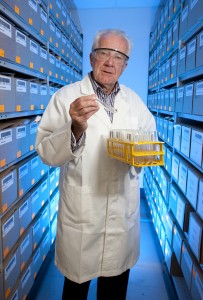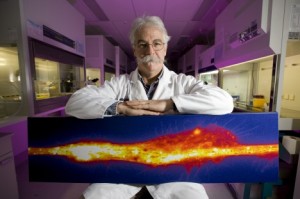Griffith University has developed the first needle-free vaccine for Strep A with the potential to help millions from suffering, uncovered the history of Aboriginal Australians in a world first genomic study and celebrated a scientist being named 2017 Queensland Australian of the Year — all in one short year.
Griffith University is at the forefront of converting research into outcomes that have an immense impact on the world.
Our research is saving lives, making history and challenging conventions.
Griffith has allocated $20 million to be invested specifically in research endeavours over three years.
An analysis of Excellence in Research for Australia 2015 found 98% of Griffith University’s research outputs were rated at world standard or above.
Griffith has more than 20 dedicated research centres and research institutes. Griffith researchers are also collaborating with over 5,000 national partners and over 200 international research agreements.
As we look forward to 2017, here are some of our research highlights this year:
$4M grant to aid Chronic Fatigue Syndrome
This year has seen a major leap in the research of Chronic Fatigue Syndrome with the awarding of $4 million in funding from the Stafford Fox Medical Research Foundation. The funding is part of a bid to accelerate the diagnosis of CFS and the discovery of appropriate treatment.
Strep A Vaccine partnership raises hope for millions
Griffith University partnered with Chinese pharmaceutical Olymvax Biopharmaceuticals Inc. for a new needle-free vaccine targeted at Streptococcus A infections, the cause of strep throat and rheumatic heart disease. The agreement allows them to discover, develop and commercialise its Group A Streptococcus vaccine technology exclusively for Greater China.
World First Genomic Study of Aboriginal Australians
Researchers discovered Indigenous Australians and Papuans are descendants of a single wave of migrants who left Africa around 70,000 years ago. Griffith University’s Research Centre of Human Evolution collaborated with nine Indigenous Aboriginal Australian Elders and an international team, to sequence the complete genomes of 83 Aboriginal Australians and 25 Highland Papuans. This research is helping to uncover some of the greatest secrets of Australia’s human past.
Indonesian Hobbits may have died out sooner than thought
A team of international scientists, including researchers from our Research Centre of Human Evolution, discovery that an ancient species of Indonesian ‘hobbits’ may have met their demise earlier than once thought. The team challenges reports that these inhabitants of remote Flores insland co-existed with modern humans for tens of thousands of years.
Professor Alan Mackay-Sim named Queensland Australian of the Year
Professor Alan Mackay-Sim was named the 2017 Queensland Australian of the Year for his workwith stem cells and how they can be used to help repair damaged spinal cords. The Emeritus Professor at Griffith’sEskitis Institute for Drug Discoveryhas given hope to thousands of Australians with spinal cord injuries through his world-leading research.
World’s largest commercial glycan array launched
The Institute for Glycomics partnered with Dextra Laboratoriesto launch the world’s largest commercial glycan array and bioanalytical service offering. This array is invaluable to study the molecular biology of diseases and will aid in the identification of new drug targets and more efficient diagnosis of disease.
Leading the world in stem cell research
Griffith University researchers’ ground-breaking work is offering new hope to paralysed patients through a new medical research centre. The Clem Jones Centre for Neurobiology and Stem Cell Research, established at Griffith University, is preparing to conduct clinical trial which focus on restoring motor and sensory function to badly injured people.
World-first fruit fly trap to capture massive agricultural gains
The ‘Holy Grail’ of fruit fly traps has been launched in move that is expected to boost Australia’s horticulture production in what is already a multibillion-dollar industry. It is also tipped to unlock overseas export markets that have been closed to Australia due to biosecurity concerns. Griffith University and agricultural product companyAgNova Technologiescollaborated to produce Fruition, the nation’s first non-toxic response to fruit flies.

Griffith University’s Eskitis Institute for Drug Discovery Professor Ron Quinn is the winner of the Lifetime Leadership award in the 2015 Vice Chancellor’s Research Excellence Awards.
Professor Quinn recognised for outstanding career
Professor Ron Quinn was announced as the winner of the Lifetime Leadership award in the 2015 Vice Chancellor’s Research Excellence Awards and was presented the Paul J Scheuer Award in Marine Natural Products Chemistry. These awards and his dedication to research cemented his reputation as an international leader in the field of Marine Natural Product drug discovery.
3D scanning helps solve WWI mystery
Griffith PhD candidate Chris Little used advanced 3D scanning to help solve one of World War I’s great mysteries. What happened to the German tank known as Mephisto has been scrutinised for almost 100 years, but Mr Little believes his research may help put an end to the speculation and take the public inside the tank for the first time.
The future of our cities is in good hands
The building of great cities was boosted by the launch of Griffith University’s new Cities Research Centre. The multi-disciplinary centre brings togethermore than 50 researchers and academic staff and more than 70 PhD students.
Can you teach a koala new tricks
Griffith University’s Environmental Futures Research Institute team have also had a successful year engaging in a world-first study that tracked Koalas more comprehensively than ever before. This study has lead to the discovery that koalas are more clever than first thought.
For more on our research initiatives visit outResearch Impactwebsite or ourNewswebsite.

